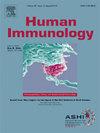miR-302d-3p expression and genotype are associated with CMV replication after allogeneic haematopoietic stem cell transplantation
IF 2.2
4区 医学
Q3 IMMUNOLOGY
引用次数: 0
Abstract
Cytomegalovirus (CMV) reactivation is a common complication after allogeneic haematopoietic stem cell transplantation (HSCT). It occurs in over a third of alloHSCT recipients, and is a major source of post-transplant mortality. miRNAs are small non-coding RNA molecules that are important regulators of gene expression. They are often dysregulated during disease, including transplant-related complications. Due to their presence in all body fluids, they can be used as potential biomarkers. In this study, we performed miRNA profiling to find differentially expressed host miRNAs in serum that could be linked to CMV reactivation after HSCT. CMV reactivation was confirmed by detection of CMV DNA in serum. We identified two miRNAs, miR-302d-3p (p < 0.001) and miR-6721-5p (p = 0.018), as differentially expressed between day + 30 and + 90 after HSCT in patients with CMV reactivation. Of these, miR-302d-3p was confirmed as overexpressed on day + 30 in a verification analysis performed on an independent cohort of patients (p = 0.027). Furthermore, we analysed two genetic variants in the gene coding for miR-302d-3p. We found one of them, rs13136737, to be significantly associated with CMV reactivation (p = 0.015). In conclusion, our study showed that miR-302d-3p is dysregulated and that its genetic variant rs13136737 may be important in development of CMV reactivation after HSCT.
miR-302d-3p的表达和基因型与同种异体造血干细胞移植后巨细胞病毒的复制有关。
巨细胞病毒(CMV)再激活是同种异体造血干细胞移植(HSCT)后常见的并发症。它发生在三分之一以上的同种异体造血移植受者中,是移植后死亡的主要原因。mirna是一种小的非编码RNA分子,是基因表达的重要调节因子。它们在疾病期间经常失调,包括移植相关的并发症。由于它们存在于所有体液中,因此可以用作潜在的生物标志物。在这项研究中,我们进行了miRNA分析,以发现血清中可能与HSCT后CMV再激活相关的差异表达的宿主miRNA。血清中巨细胞病毒DNA检测证实巨细胞病毒再激活。我们鉴定了两个mirna, miR-302d-3p (p
本文章由计算机程序翻译,如有差异,请以英文原文为准。
求助全文
约1分钟内获得全文
求助全文
来源期刊

Human Immunology
医学-免疫学
CiteScore
5.40
自引率
7.40%
发文量
107
审稿时长
12 days
期刊介绍:
The journal''s scope includes understanding the genetic and functional mechanisms that distinguish human individuals in their immune responses to allografts, pregnancy, infections or vaccines as well as the immune responses that lead to autoimmunity, allergy or drug hypersensitivity. It also includes examining the distribution of the genes controlling these responses in populations.
Research areas include:
Studies of the genetics, genomics, polymorphism, evolution, and population distribution of immune-related genes
Studies of the expression, structure and function of the products of immune-related genes
Immunogenetics of susceptibility to infectious and autoimmune disease, and allergy
The role of the immune-related genes in hematopoietic stem cell, solid organ, and vascularized composite allograft transplant
Histocompatibility studies including alloantibodies, epitope definition, and T cell alloreactivity
Studies of immunologic tolerance and pregnancy
T cell, B cell, NK and regulatory cell functions, particularly related to subjects within the journal''s scope
Pharmacogenomics and vaccine development in the context of immune-related genes
Human Immunology considers immune-related genes to include those encoding classical and non-classical HLA, KIR, MIC, minor histocompatibility antigens (mHAg), immunoglobulins, TCR, BCR, proteins involved in antigen processing and presentation, complement, Fc receptors, chemokines and cytokines. Other immune-related genes may be considered.
Human Immunology is also interested in bioinformatics of immune-related genes and organizational topics impacting laboratory processes, organ allocation, clinical strategies, and registries related to autoimmunity and transplantation.
 求助内容:
求助内容: 应助结果提醒方式:
应助结果提醒方式:


